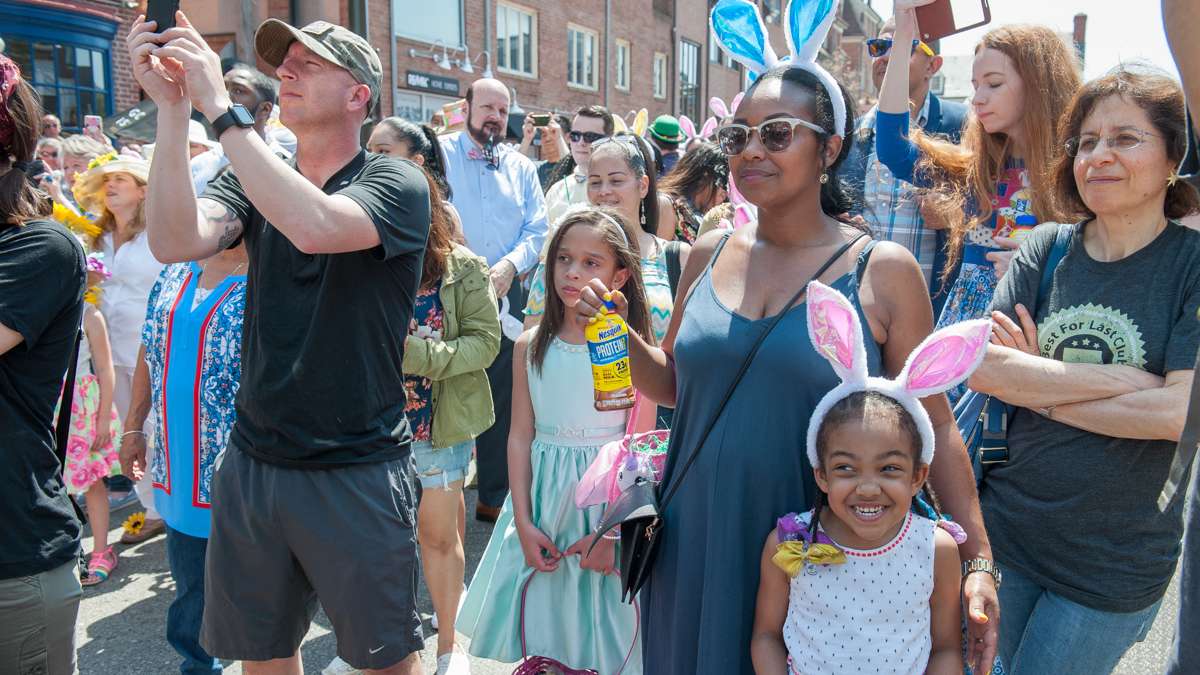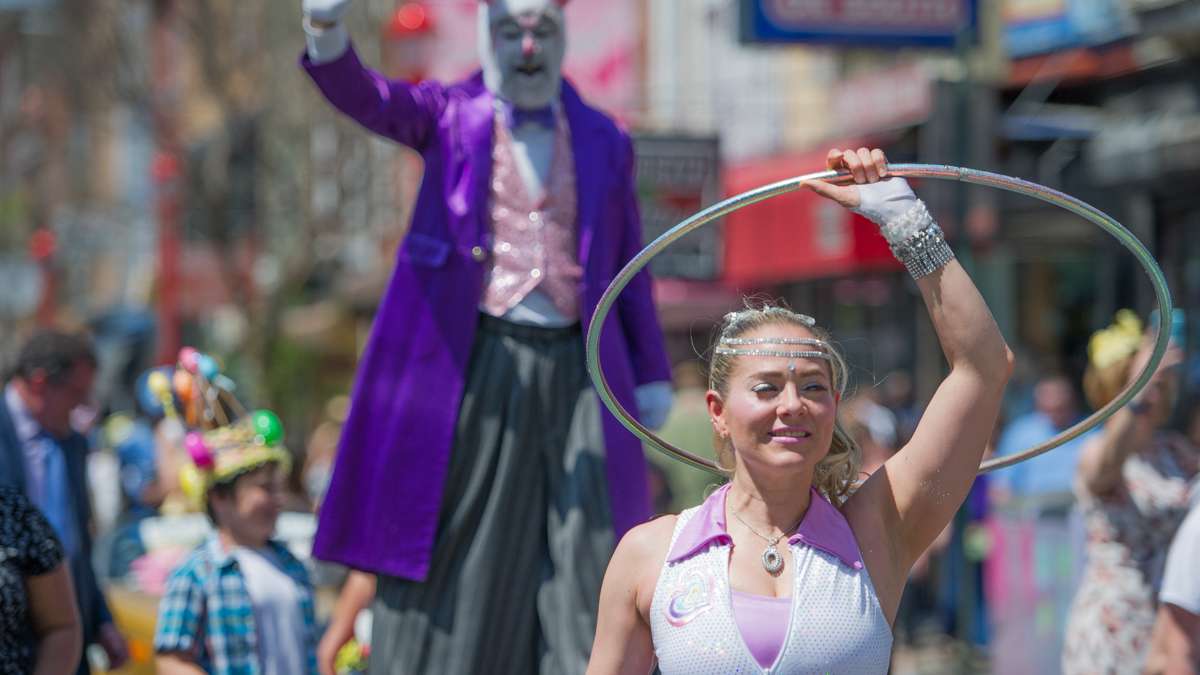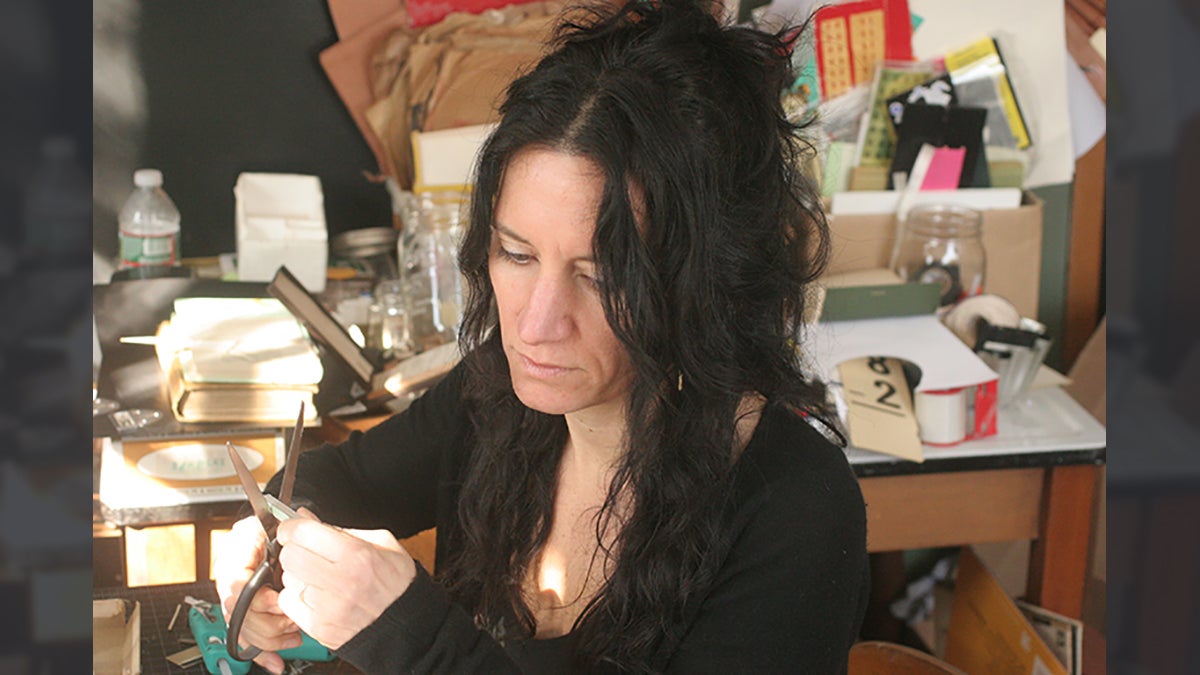Narberth woman makes tiny sculptures from scraps [photos]
Listen-

The contestants in the best-dressed woman category line the stage. (Jonathan Wilson for WHYY)
-

Winner of the boys' best-dressed, 2-to-5-year-old, contest, Marcus Henry, was held aloft to receive his prize. (Jonathan Wilson for WHYY)
-

From left: Philadelphia sisters Heidi, Marsha, and Fran Connolly, watch the best-dressed contestants. (Jonathan Wilson for WHYY)
-

Crowds gather around the judging stage at Headhouse Square to watch the best-dressed contest. (Jonathan Wilson for WHYY)
-

The first contestant in the best-dressed girl, 2-to-5-year-old category, walks onto the stage. (Jonathan Wilson for WHYY)
-

Nace Mullen III examines an Easter egg he found in his gift basket while awaiting the judging for the best-dressed boys, 2-to-5-year-old, category. (Jonathan Wilson for WHYY)
-

Families line South Street from 5th Street to Headhouse Square. (Jonathan Wilson for WHYY)
-

Benjamin Nguyen holds his son, Levi, aloft to view the parade. (Jonathan Wilson for WHYY)
-

Hula Hoop performer Jennifer Alvarez entertains the South Street crowds. (Jonathan Wilson for WHYY)
-

A contingent of a half dozen rabbits do the bunny hop along South Street. (Jonathan Wilson for WHYY)
-

Parade veteran Henri David (center) poses for photos, while Philadelphia Mayor Jim Kenny adjusts his rabbit ears. (Jonathan Wilson for WHYY)
-

The Philadelphia Freedom Band marches along South Street. (Jonathan Wilson for WHYY)
-

Edward Coleman poses in his Easter attire while sporting a pair of rabbit ears. (Jonathan Wilson for WHYY)
-

From left: Noodle and Diva, owned by Anthony Smith, won the best-dressed pet category. (Jonathan Wilson for WHYY)
-

On stilts, Dale Varga waves to the crowd that lined South Street for the annual Easter Promenade in South Philadelphia. (Jonathan Wilson for WHYY)
-

-

-

-

A cement truck, a pinball machine, a beam scale, a cash register, several cars, and a trapeze all fit inside Lydia Ricci’s cozy, messy office. The items are so small, they can sit in your palm — and all are made from scraps.
In fact, that’s what Ricci calls her work: “from scraps.” She constructs the diminutive, three-dimensional pieces from found objects. Everywhere she goes, the Narberth woman searches for bits and bobs that catch her eye.
In her daily life, Ricci is a freelance graphic designer. She co-produces the podcast “Roam Schooled,” and she teaches. She is married to a children’s book illustrator and has two sons, 7 and 9. And Ricci just launched the podclubs — bookclubs for listeners. But at night, she digs into her boxes of scraps.
 Lydia Ricci of Narberth, Pa. constructs tiny, three-dimensional pieces from found objects. She calls her work ‘from scraps.’ (Photo provided)
Lydia Ricci of Narberth, Pa. constructs tiny, three-dimensional pieces from found objects. She calls her work ‘from scraps.’ (Photo provided)
Ricci began making her tiny sculptures years ago with just about anything she could find.
“I would call these my valuable possessions,” Ricci said about her boxes of cardboard cast-offs, paper shreds, pieces of metal, and a random assortment of what most other people would consider garbage.
“It’s like a lot of old office supplies,” she said. “It’s just the color and the texture and the way the metal mixes or something. And then I realized I can cut some of this stuff up, and I can maybe honor it in a different way. So then I realized anything was up for grabs.”
Ricci believes objects hold memory, especially the ones you interacted with the most. And she recreates them — often things that remind her of her past — not exact replicas but representations of important objects that have meaning for her.
Ricci made a miniature model of her family’s first color TV out of found pieces of cardboard. She glued an old photograph of a house on the front as the screen. This TV meant so much to her that she wanted to reproduce it — right down to the red, blue, and green buttons that indicated it was a color set.
“I remember my dad sitting it down in the living room,” Ricci said. “He took it out of the box, and I knew something was up. I saw that jewel — that red jewel and the green jewel and the blue jewel, and I just looked at him. And I said, ‘Is this color? Is this a color TV?’”
Ricci has an adoring Facebook following. Cherry Bombe magazine is featuring her work. This spring, Simon & Schuster is publishing two journals of Ricci’s paper-craft objects to inspire others to create their own work from scraps. The journals will be available at Target and on Amazon.com.
Her latest piece is a tiny replica of a beam scale, the old-fashioned kind still used in some doctors’ offices.
“I think it’s the end of the winter and just feeling the weight of winter and the clothes,” Ricci said. “I was thinking about how when you go to the doctor’s office, and they’re like, ‘Get on the scale.’ And so quickly you just want to take everything off.”
Ricci likes her pieces to have a slightly rough-around-the-edges look — not to be too perfect. “Because then it’s like doll furniture,” she says. “And that’s bad.”
Ricci is incredibly prolific. Part of the reason, she says, is that she lost her mother when she was a freshman in college.
“You realize you don’t have infinity,” Ricci said about having to face mortality at such a young age. “You get your priorities straight. I’m very productive because of that.”
Losing her mother may also have something to do with why Ricci spends so much time creating objects from her past — to hold on to special memories from childhood and bring them back to life. And it helps that her father still lives in the house where she grew up in King of Prussia.
“He has not thrown a thing away,” Ricci said. “So it’s very convenient. I can just go around, and I can fill up a bin of ‘inspiration’ in 10 to 15 minutes.”
She said she finds the process of recreating objects from scraps to be both satisfying and freeing.
“At the end, you’re not like, ‘Oh, if I do this, am I going to mess the whole thing up?’ If you do, you just cover it up with another piece of paper.”
WHYY is your source for fact-based, in-depth journalism and information. As a nonprofit organization, we rely on financial support from readers like you. Please give today.




